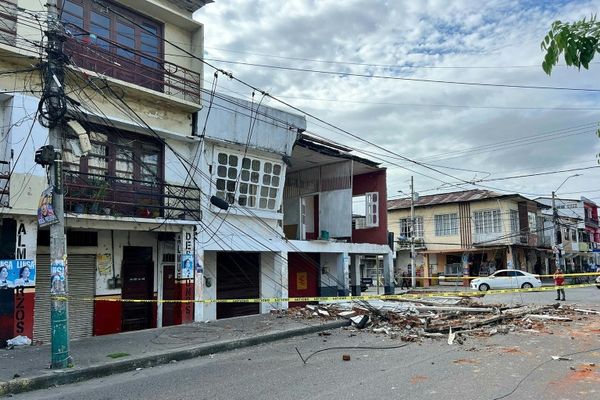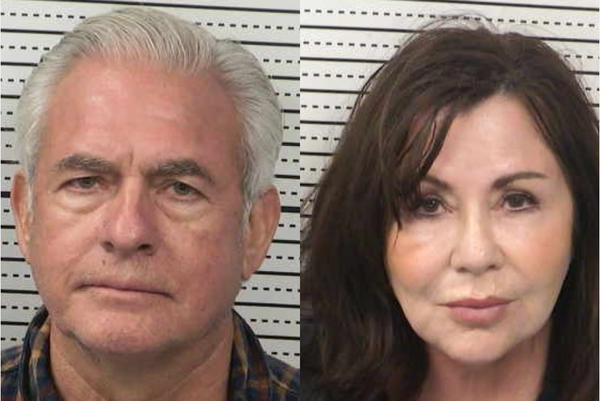
Home is where the heart is but it also brought hardships for the National Black Theatre (NBT). “We have always produced in this space, but it was with a leaky roof, with low ceilings,” recalls Sade Lythcott, the chief executive. “Our artistic ambition was always stifled by the space that we had.”
That is about to change when the NBT, a groundbreaking organisation forged in the searing political heat of 1968, prepares to move into a major new arts complex spanning an entire city block on 125th Street in Harlem, New York. Set to open in 2027, the $80m project will contain two hi-tech theatres as well as affordable artist housing, a set-building shop and site-specific installations by artists Sanford Biggers and José Parla.
Speaking via Zoom from her home office in Harlem, Lythcott adds: “What we’re building, I can’t say it enough, is singular. This does not exist probably on the planet but definitely not in America. We’re building the premiere destination for Black theatre in the country. From page to stage to Broadway.”
It will be a poignant transition for Lythcott, whose mother, Barbara Ann Teer, was an actor, dancer, pioneer of the Black arts movement – and founder of the NBT. Over decades, she turned it into America’s first revenue-generating Black arts complex, the longest-running Black theatre in New York and one of the oldest theatres founded and consistently operated by a woman of colour.
Lythcott explains: “My mom was kind of a savant, went to college at 15, graduated. She thought she wanted to study biology. She probably remained a scientist her whole life because NBT in so many ways is this experiment of Black liberation and joy and the impact and the hypothesis of it and then watching that experiment live and produce in the world.”
Teer’s successful career as a dancer was cut short by an accident and she switched to acting, but roles were scarce for women of colour. Meanwhile, her sister, Fredrica Teer, was pursuing work as a humanitarian and activist – she was one of the architects of the free breakfast programme for the Black Panthers.
Lythcott continues: “There was this existential crisis that she was going through in the early 60s after having lost a prominent career, feeling so marginalised by the kind of roles and the treatment she was getting on stage and screen. The country similarly: 68 is so similar to this year that we find ourselves in now. The wars that were being protested, the fight for civil and human rights, pushed her.”
Teer joined with the actor Robert Hooks to start a small theatre school in his apartment. She saw first-hand a generation of young, talented Black actors and writers who had no outlet. Film, theatre and TV were still white-dominated arenas with few rounded Black characters.
Lythcott says: “There was also an urgency around how we were depicted, the inaccuracies, the flattening of who we are, the butt of every joke, the sultry, salacious temptress, these two-dimensional characters. Where we did exist, we were not whole, and half-people can never heal wholly.
“A part of it was, yes, representation, but the other part was a real deliberate mission to heal and give our wholeness back to ourselves, and so she was interested in course-correcting the inaccuracies of Black life through this storytelling mode of theatre.”
Teer was inspired by a speech given by Martin Luther King before his assassination in 1968 in which he urged the building of Black institutions. She moved to Harlem and created the NBT in a building that had been a three-storey jewellery factory, where artists had converted lofts into performance spaces. It was the time of the Black arts movement and “Black is beautiful”.
Lythcott adds: “It was a place where she wanted to experiment with the form and to turn what she experienced as a self-conscious art form into a God-conscious art form that would heal our community, because she understood through the practice and the making of the work that storytelling – and the stories we tell ourselves, our community, our babies – are the things that shape the arc of our future. She wanted to be in a space of storytelling in service of the liberation of her people.”
Teer’s theatre practice was experimental and avant-garde, breaking traditional forms by following the rhythm and beat of Indigenous rituals. She did not call the members of her first company “actors” but rather “liberators” who were required to liberate themselves from the white gaze.
She say: “They were charged to embody these stories of liberation in order to activate our audiences. It felt like church. People were like, ooh, you come to National Black Theatre and get the holy ghost. You couldn’t do that on Broadway.”
Actors such as Phylicia Rashad, Samuel L Jackson, Michael K Williams and Donald Faison graced the theatre’s stage. Alongside productions, there were “Blackening” symposiums featuring the likes of James Baldwin, Maya Angelou, Nina Simone, Gwendolyn Brooks and Langston Hughes.
Lythcott, who took over as chief executive in 2009 after her mother’s death, says: “What we’re the most proud of are the playwrights that have been developed through having NBT as a home. Every Pulitzer award-winning Black playwright has found some kind of support through the theatre.”
Last year, the NBT made its Broadway debut with the transfer and co-production of Fat Ham, an adaptation of Hamlet by James Ijames that swapped the Elsinore castle for a North Carolina barbecue pit.
Lythcott describes Fat Ham as “quintessentially National Black Theatre, this ultimate Black liberatory experiment that is a response to course-correcting our narratives through the lens of Shakespeare. On its nose, it’s a story about a fat Black queer southern coming-of-age story, but James’s genius is to be able to bring many people to the theatre, do it through the lens of Hamlet.”
It was the first time in more than four decades that any Black theatre company had transferred a show to Broadway. The experience gave Lythcott an insight into how little had changed since her mother’s career despite the more recent racial reckoning that followed the police murder of George Floyd.
Sitting at the first preview performance, she thought: “‘This is an accomplishment.’ It’s not a destination because it didn’t feel safe. I penned something around that time where I was like: ‘Wow, this is 62 years after my mother left Broadway. Here we find ourselves and it’s still got some of the same trappings.’
“The commercial work that has developed since has been one of the greatest heists of our time that no one sees. The thing that put a fire in my belly, to say not to retreat, but to say I’m coming back the next season, is that the majority of Black theatre today is made in white spaces by white producers for white audiences. Quiet as it’s kept, only today they’re reckoning with how problematic it is.
“But the majority of producers’ approach to the problem is not the investment in Black spaces in the partnership, but it is like, can we do this without a Black producer? There’s still a flattening of who we are, how we are, what we contribute, what our value is. This cultural currency that my mother knew was actually the most valuable thing we’re bringing to Broadway when NBT comes.”
The NBT was one of the producers behind this year’s Broadway revival of Purlie Victorious, a comedy by Ossie Davis about a preacher scheming to save his church in the Jim Crow south, starring Leslie Odom Jr and Kara Young. Young’s victory as best featured actress in a play gave the NBT its first Tony award.
The NBT’s upcoming season is themed The Pilgrimage: A Journey Back Home and inspired by the Negro Motorist Green Book, an annual guidebook for African American road trippers published by New York mail carrier Victor Hugo Green from 1936 to 1967. The Green Book became “the bible of Black travel” during the era of Jim Crow laws, identifying services and places relatively friendly to African Americans so they could find lodging, businesses and petrol stations that would serve them along the road.
The NBT’s own journey home will follow with the opening of its expansive new building, designed by renowned architect Frida Escobedo, at the same address where Teer founded the company more than half a century ago. Lythcott cannot wait.
She says: “We believe that our people should be able to experience themselves fully in a space. It’s hard work and it’s a huge lift and it’s a fundraising muscle that is on steroids that I never, ever fathomed. But I know two things to be true:
“When my mother purchased this city block, her desire was to build an ecosystem where Black artists could live, work and serve. She wanted to buy the intersection of Fifth Avenue and 125th Street, the heart of Harlem, the cultural capital of the Black world, and build a temple of liberation and theatre-making and storytelling for her people. There’s a part of me that that wakes me up every day to understand that I am finishing the unfinished song of my mother.
“But also in order for us to exist as a people in the future, we have to be able to see it to be it. What does it mean for Black writers, storytellers, actors who can’t see the embodiment of their culture anywhere? What characters, what stories are lost when they’re developed in spaces that don’t see themselves as fully human or understand the human condition of our people? It’s very exciting and it’s important.”
Since 2012, the NBT’s artistic director has been Jonathan McCrory, who is keenly aware that, just as in the year of the theatre’s founding, America’s politics are on edge and the line between activist and artist is blurred. He hopes the NBT’s new season can offer healing.
He says via Zoom: “In thinking about 2024, in a moment where we have a presidential election where the vitriol and the racial language and emotional language is so clear, so present and so tense, how can we be a part of the antidote? How can we remind as a medicine that we once had not as a racial frame but as a cultural frame to traverse this current moment?
“This is not about a season that’s saying that only Black folks can traverse with us. This is a season that’s actually uplifting a tool and a medicine that art can provide and we know what it can do if we know the safe and the soft space and the courageous space for us to land. What if National Black Theatre’s season was those courageous soft spaces to land?”
Amid the coronavirus pandemic and Black Lives Matter protests that followed Floyd’s murder, a record seven works by Black playwrights opened on Broadway in the autumn or 2021. But that momentum has been difficult to sustain. What is McCrory’s view of the current state of plays?
“This sector is in a very volatile state and hasn’t settled yet,” he says. “The president of the NEA [National Endowment for the Arts] says it best: we are in the midst of chaos and in the midst of chaos there are two opportunities. Chaos can produce the transformation of stability and chaos can produce the transformation of instability.
“Our sector needs investment, documentation and commitment in order to right the ship or it will transform into something that I don’t think future generations will enjoy or be appreciative of because they will haemorrhage. There’s a haemorrhaging that is potentially happening.”
McCrory adds: “When the George Floyd moment and Covid moment happened, there was an influx in our sector that was very much appreciated but it was unsustainable. From the influx that happened inside of the financial well-being, the sustainability, the focus, rose the kind of appetite and institutional model that was like, what happens to those funds after year three? How do you replace that money? Our sector is reeling from that and trying to figure out: how does it find itself stable in an ever-changing economic frame? That is what we’re witnessing on a day-to-day basis.”










